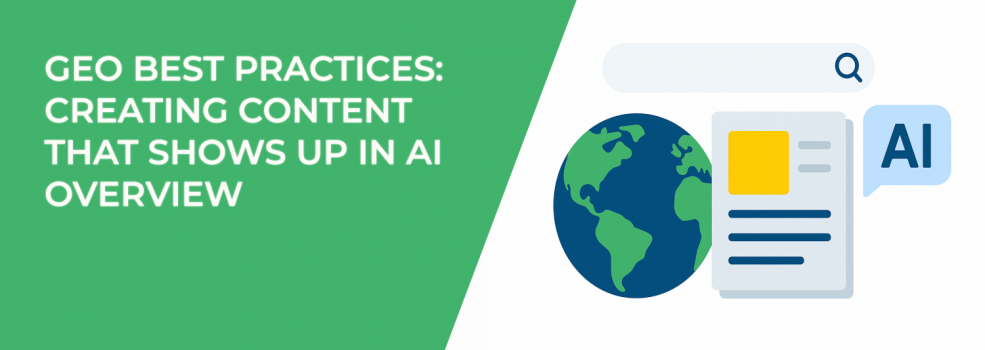Search isn’t what it used to be — and if you’re still only optimizing for traditional SEO, you’re leaving visibility (and money) on the table.
Google’s AI Overviews and other generative search features are reshaping how users discover and engage with content. Instead of serving up a list of links, AI tools synthesize the most relevant and trustworthy content into a single, digestible summary at the top of the page.
So the big question is: how do you make sure your content gets picked?
Enter Generative Engine Optimization (GEO) — the next evolution in content strategy.
Let’s unpack what GEO really means, why it matters, and how advertisers and marketers can create content that actually shows up in AI Overviews and other generative search results.
What Is GEO and Why Should You Care?
GEO (short for Generative Engine Optimization) is the practice of structuring and writing your content so that it gets selected by AI-powered search systems. These systems — like Google’s Search Generative Experience (SGE) — don’t crawl and index pages the way traditional search engines used to.
Instead, they read your content more like a human would: scanning for clear answers, factual information, and well-organized structures they can quickly synthesize into a summary.
If your content is buried in fluff, lacks structure, or doesn’t answer real questions? You’re invisible.
Why it matters for advertisers:
-
AI-generated summaries appear above all other results. If you’re not featured there, users might never scroll down to find you.
-
Click-through rates drop dramatically when you’re not in the AI box. Visibility equals traffic, and traffic equals leads.
-
Trust is shifting. If your content is quoted or summarized by AI, users start to see you as an authority — even before they click.
You can’t just “write well” anymore. You need to write strategically.
If you want to understand how AI is fundamentally changing advertising, check out How AI Is Changing Facebook Ads Forever. It breaks down the transition from manual optimization to machine-learning-driven content delivery.
GEO Best Practices for AI Overview Optimization
To help your content stand out in the age of generative search, here are five essential GEO best practices — each explained with practical tips and insights for marketers and advertisers.
1. Answer Real Questions — Quickly and Clearly
AI tools are built to serve users fast answers to specific questions. If your content beats around the bush or buries the answer in a sea of intro text, it’s unlikely to be included.
Here’s how to do it right:
-
Use natural, conversational language that mirrors the way people search. Think: “What is programmatic advertising?” rather than “An in-depth exploration of advertising models.”
-
Front-load your content with the answer. Ideally, the first 1–2 sentences of a section should directly address the query.
-
Use headers (H2s and H3s) that reflect user questions. For example, instead of a generic heading like “Benefits,” write “What Are the Benefits of AI-Powered Ad Targeting?”
This makes it easier for AI to understand the structure of your content and extract the most relevant parts.
Want to future-proof your strategy? This piece on Ad Targeting: What Marketers Need to Know in 2025 explains how AI-driven targeting is shaping user intent discovery.
2. Structure Content for AI — and Humans
AI engines prioritize content that’s clean, scannable, and logically organized. If your article is a long wall of text, it won’t get picked — and human readers will bounce too.
To structure content effectively:
-
Use bullet points and numbered lists to break down complex concepts into digestible pieces.
-
Keep paragraphs short — two to four lines max.
-
Maintain a logical flow from intro to conclusion.
-
Include tables or comparisons for clarity.
This structure mirrors what generative engines prioritize — highly structured, semantically clear content with clear sections and questions.
For marketers leveraging AI across the board, you’ll want to read How to Improve Campaign Performance With AI Tools. It shows how performance gains aren’t just about ads — content plays a big role too.
3. Go Deep, But Stay Focused
Broad, unfocused pages don’t win in AI Overviews. The systems are designed to pick up precise, reliable, and topic-rich content.
Here’s how to strike the balance:
-
Stick to one main intent per page. Don't drift into unrelated topics.
-
Use examples, expert quotes, and stats. This signals depth and authority.
-
Cover angles users might search for. Benefits, comparisons, risks, and FAQs all help.
One smart way to add value? Review how modern platforms use AI to connect the dots. For example, The Future of Ad Targeting: Trends to Watch offers a peek into how AI is rewriting the rules of relevance.
4. Keep It Factual, Trustworthy, and Up to Date
Outdated or vague content is a red flag for both search engines and AI systems. Trustworthiness is non-negotiable.
To signal trust:
-
Use real data, cited sources, and avoid hype.
-
Update regularly — especially for fast-evolving industries like AI or digital ads.
-
Stick to language that’s specific and grounded.
Pages that do this well tend to outperform even heavily optimized SEO content in AI-generated summaries.
5. Use Clear, Branded Language — But Cut the Jargon
Even with a strong brand voice, clarity should always come first.
-
Avoid filler words that make content sound vague.
-
Keep definitions simple and to-the-point.
-
Make sure even a non-expert could understand your page.
And remember — AI can’t summarize what it can’t understand. When your writing is clean and purposeful, your brand is more likely to be quoted, linked, and trusted by both AI and users.
Bonus: Content Types That Win in AI Overviews
Certain formats consistently perform better in AI Overviews:
-
How-to guides — Ideal for users searching for steps or frameworks.
-
FAQs — Provide quick answers to common questions.
-
Glossaries — Define industry terms for top-of-funnel users.
-
Comparison articles — Especially with structured tables or pros/cons.
-
Short explainers — Help AI systems extract core ideas quickly.
If you're working on a strategy to improve content discoverability, make these your go-to formats.
Final Thoughts: GEO Is the New SEO
You don’t have to abandon everything you know about SEO. But if you want to stay competitive in a generative-first world, you do need to level up your content strategy.
Ask yourself:
-
Would this content be helpful if shown in an AI summary?
-
Does it feel current, relevant, and trustworthy?
-
Is it clear and structured enough to be quoted without confusion?
If yes, you’re already on the path to GEO success.

